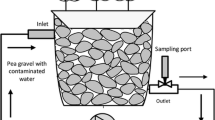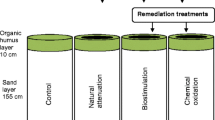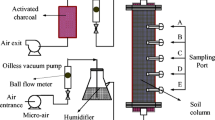Abstract
The objective of this study was to test the effectiveness of a nitrate-rich nutrient solution and hydrogen peroxide (H2O2) to enhance in-situ microbial remediation of toluene in the unsaturated zone. Three sand-filled plots were tested in three phases (each phase lasting approximately 2 weeks). During the control phase, toluene was applied uniformly via sprinkler irrigation. Passive remediation was allowed to occur during this phase. A modified Hoagland nutrient solution, concentrated in 150 L of water, was tested during the second phase. The final phase involved addition of 230 moles of H2O2 in 150 L of water to increase the available oxygen needed for aerobic biodegradation.
During the first phase, measured toluene concentrations in soil gas were reduced from 120 ppm to 25 ppm in 14 days. After the addition of nutrients during the second phase, concentrations were reduced from 90 ppm to about 8 ppm within 14 days, and for the third phase (H2O2), toluene concentrations were about 1 ppm after only 5 days. Initial results suggest that this method could be an effective means of remediating a contaminated site, directly after a BTEX spill, without the intrusiveness and high cost of other abatement technologies such as bioventing or soil-vapor extraction. However, further tests need to be completed to determine the effect of each of the BTEX components.
Similar content being viewed by others
References
Alexander, M.: 1961, Introduction to Soil Microbiology, John Wiley & Sons, Inc., New York, NY, 472 pp.
Atlas, R. M.: 1981, ‘Microbial degradation of petroleum hydrocarbons: An environmental perspective’, Microbiology Review 45, 180–209.
Beller, H. R. and Spormann, A. M.: 1997, ‘Anaerobic activation of toluene and o-xylene by addition to fumarate in denitrifying strain T’, J. Bacteriol, 179(3), 670–676.
Biegert, T., Fuchs, G. and Heider, J.: 1996, ‘Evidence that anaerobic oxidation of toluene in the denitrifying bacterium Thauera aromatica is initiated by formation of benzylsuccinate from toluene and fumarate’, Eur. J. Biochem. 238(3), 661–668.
Bird, R. B., Stewart, W. and Lightfoot, E.: 1960, Transport Phenomena, Wiley, New York.
Borden, R. C.: 1994, ‘Natural bioremediation of hydrocarbon contaminated ground-water’, in R. D. Norris (ed.), Handbook of Bioremediation, Lewis Publishers, Inc., Boca Raton, FL, pp. 177–199.
Butler, J. N.: 1982, Carbon Dioxide Equilibria and Their Applications, Addison-Wesley Publishing Company, Reading, MA, 259 pp.
Calabrese E. J. and Kostecki, P. T.: 1989, Petroleum Contaminated Soils, Vol. 2. Lewis Publishers, Inc., Chelsea, MI, 357 pp.
Capuano, R. M. and Johnson, M. A.: 1996, ‘Geochemical reactions during biodegradation/vapor extraction remediation of petroleum contamination in the vadose zone’, Ground Water 34(1), 31–40.
Chapelle, F. H.: 1993, Ground-Water Microbiology and Geochemistry, John Wiley and Sons, Inc., New York, NY, 404 pp.
Cookson, J. T.: 1995, Bioremediation Engineering: Design and Application, McGraw Hill, Inc., New York, NY, 524 pp.
Cooper, W. J. and Zepp, R. G.: 1990, ‘Hydrogen peroxide decay in waters with suspended soils: Evidence for biologically mediated processes’, Canada J. Fish. Aquat. Sci. 47, 888–893.
De Marsily, G., Gillham, R. W., Mc Carty, P. L. and Rao, P. S. C.: 1992, ‘Hydrogen peroxide use to increase oxidant capacity for in situ bioremediation of contaminated soils and aquifers: A Review’, Contaminant Hydrology 9, 221–242.
Dibble, J. T. and Bartha, R.: 1979, ‘Effects of environmental parameters on the biodegradation of oil sludge’, Applied and Environmental Microbiology 37, 729–739.
Hess, L.: 1993, Denitrification vs. Aerobiosis-Microbial Degradation of the Gasoline Constituent Toluene in Aquifers with Low Hydraulic Conductivities, MSc. Thesis, Brigham Young University, Provo, UT.
Hinchee, R. E.: 1994, ‘Bioventing of petroleum hydrocarbons’, in R. D. Norris (ed.), Handbook of Bioremediation, Lewis Publishers, Inc., Boca Raton, FL, pp. 39–59.
Howard, P. H., Boethling, R. S., Jarvis, W. F., Meyland, W. M. and Michalenko, E. M.: 1991, HandBook of Environmental Degradation Rates, Lewis Publishers, Inc., Chelsea, MI.
Huertas, M. J., Duque, E., Marques, S. and Ramos, J. L.: 1998, ‘Survival in soil of different toluene-degrading Pseudomonas strains after solvent shock’, Appl. Environ. Microbiol. 64, 38–42.
Hutchins, S. R., Downs, W. C., Wilson, J. T., Smith, G. H., Kovacs, D. A., Fine, D. D., Douglas, R. H. and Hendrix, D. J.: 1991, ‘Effects of nitrate on bioremediation of fuelcontaminated aquifer: Field demonstration’, Ground Water 29, 571–580.
King, B. R., Long, G. M. and Sheldon, J. K.: 1998, Practical Environmental Bioremediation: The Field Guide, Lewis Publishers, Inc., Boca Raton, FL, 184 pp.
Kobayashi, H. and Rittman, B. F.: 1982, ‘Microbial removal of hazardous organic compounds’, Environ. Sci. Technol. 16: 170A–183A.
Kota, S., Barlaz, M. A. and Borden, R. C.: 2004, Spatial Heterogeneity of Microbial and Geochemical Parameters in Gasoline Contaminated Aquifers. Practice Periodical of Hazardous, Toxic, and Radioactive Waste Management, Vol. 8, No. 2, April 2004, pp. 105–118.
Lyman, W. J., Reehl, W. F. and Rosenblatt, D. H.: 1990, Handbook of Chemical Property Estimation Methods-Environmental Behavior of Organic Compounds, American Chemical Society.
Manahan, S. E.: 1994, Environmental Chemistry, 6th edn., Lewis Publishers, Inc., Boca Raton, FL, 811 pp.
Millington, R. J.: 1959, Gas Diffusion in Porous Media: Science, v. 130, pp. 100–102.
Montgomery, J. H.: 1996. Groundwater Chemicals: Desk Reference, 2nd edn., Lewis Publishers, Inc., Boca Raton, FL, 1345 pp.
Norris, R. D.: 1994, ‘In-situ bioremediation of soils and ground water contaminated with petroleum hydrocarbons’, in R. D. Norris (ed.), Handbook of Bioremediation, Lewis Publishers, Inc., Boca Raton, FL, pp. 17–37.
Pardieck, D. L., Bouwer, E. J. and Stone, A. T.: 1992, ‘Hydrogen peroxide use to increase oxidant capacity for in-situ bioremediation of contaminated soils and aquifers: A review’, Contaminant Hydrology 9, 221–242.
Parkhurst, D. L. and Appelo, C. A. J.: 1999, ‘User's guide to Phreeqc Version 2–A computer program for speciation, batch-reaction, one-dimensional transport, and inverse geochemical calculations: U.S. Geol’, Survey Water Res. Inv. Rpt. 99–4259, 312 p.
Penman, H. L.: 1940, ‘Gas and vapour movements in the soil, 1, The diffusion of vapors through porous solids’, Journal of Agricultural Science 30, 437–462.
Perry, R. H. and Chilton, C. H.: 1973, Chemical Engineers Handbook, McGraw-Hill, New York, 1958 pp.
Powers, S. E., Louriero, C. O., Abriola, L. M. and Weber, W. J.: 1991, ‘Theoretical study of nonequilibrium dissolution of nonaqueous phase liquids in subsurface systems’, Water Resour. Res. 27(4), 463–478.
Reinhard, M.: 1994, ‘In-situ bioremediation technologies for petroleum-derived hydrocarbons based on alternative electron acceptors (other than molecular oxygen)’, in R. D. Norris (ed.), Handbook of Bioremediation, Lewis Publishers, Inc., Boca Raton, FL, pp. 131–147.
Riser-Roberts, E.: 1992, Bioremediation of Petroleum Contaminated Sites, Smoley Publishers, Boca Raton, FL, 197 pp.
Rittman, B. E., Seagren, E., Wrenn, B. A., Valocchi, A. J., Ray, C. and Raskin, L.: 1994, In Situ Bioremediation, 2nd edn., Noyes Publications, Park Ridge, NJ, 260 pp.
Shields, M. S., Montgomery, S. O., Chapman, P. J., Cuskey, S. M. and Pritchard, P. H.: 1990, ‘The involvement of a toluene degradative pathway in the diodegradation of trichloroethylene by pseudomonas cepacia strain G4’, in Bioremediation of Hazardous Wastes. EPA/600/0-90/041. U.S. Dept. of Commerce, Washington, DC, pp. 49–52.
Snoeyink, V. L. and David Jenkins.: 1980, Water Chemistry, John Wiley & Sons, Inc., New York, NY, 472 pp.
Stotzky, G. and Norman, A. G.: 1961, ‘Factors limiting microbial activities in soil. I. The level of substrate, nitrogen, and phosphorous’, Arch. Microbiol. 40, 341–369.
Striegl, R. G.: 1993, ‘Diffusional limits to the consumption of atmospheric methane by soils’, Chemosphere 26, 715–720.
Texas Research Institute, 1982. Enhancing the Microbial Degradation of Underground Gasoline by Increasing Available Oxygen. API Publication 4428, American Petroleum Institute, Washington, DC.
Tindall, J. A. and Kunkel, J. R.: 1999, Unsaturated Zone Hydrology for Scientists and Engineers, Prentice Hall, Upper Saddle River, NJ, 624 pp.
Tindall, J. A., Petrusak, R. L. and McMahon, P. B.: 1995, ‘Nitrate transport and transformation processes in unsaturated porous media’, Journal of Hydrology 169, 51–94.
Tortora, G. J., Funke, B. R. and Case, C. L.: 1992, Microbiology: An Introduction. The Benjamin/Cummings Publishing Company, Inc., Redwood City, CA, 809 pp.
U.S. Environmental Protection Agency: 1988, The UST Program Appraisal Strategy OSWER Directive 9610.6 May 6, 1988. U.S. Government Printing Office. Washington, DC, pp. 4–8.
Verschueren, D. K.: 1983, Handbook of Environmental Data on Organic Chemicals. Van Nostrand Reinhold, New York, NY, 1310 pp.
Wilson, J. T., Peterson, D. N. and Ostrye, T. F.: 1986, ‘In-situ biorestoration as a ground water remediation technique’, Ground Water Monitoring Review 6(4), 56–64.
Author information
Authors and Affiliations
Corresponding author
Additional information
The use of firm, trade, or brand names in this paper is for identification purposes only and does not constitute endorsement by the U.S. Geological Survey.
Rights and permissions
About this article
Cite this article
Tindall, J.A., Weeks, E.P. & Friedel, M. Part 2: A Field Study of Enhanced Remediation of Toluene in the Vadose Zone Using a Nutrient Solution. Water Air Soil Pollut 168, 359–389 (2005). https://doi.org/10.1007/s11270-005-3584-4
Received:
Accepted:
Issue Date:
DOI: https://doi.org/10.1007/s11270-005-3584-4




